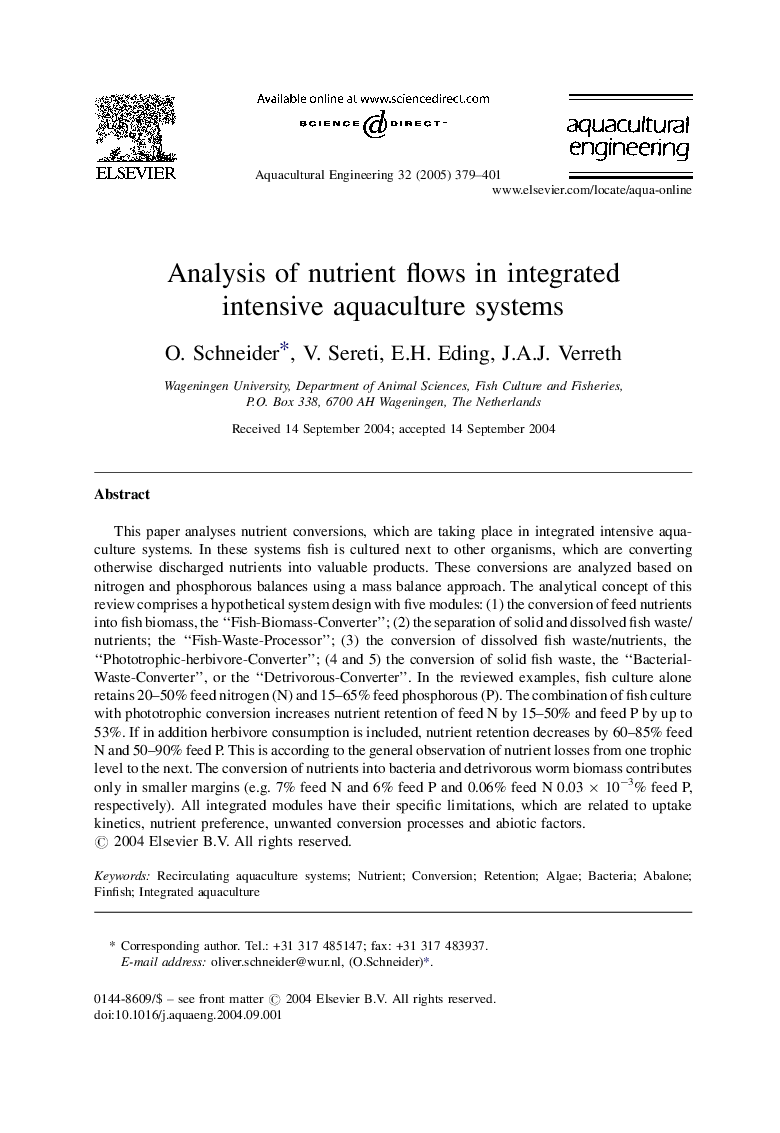| کد مقاله | کد نشریه | سال انتشار | مقاله انگلیسی | نسخه تمام متن |
|---|---|---|---|---|
| 9477348 | 1625727 | 2005 | 23 صفحه PDF | دانلود رایگان |
عنوان انگلیسی مقاله ISI
Analysis of nutrient flows in integrated intensive aquaculture systems
دانلود مقاله + سفارش ترجمه
دانلود مقاله ISI انگلیسی
رایگان برای ایرانیان
کلمات کلیدی
موضوعات مرتبط
علوم زیستی و بیوفناوری
علوم کشاورزی و بیولوژیک
علوم آبزیان
پیش نمایش صفحه اول مقاله

چکیده انگلیسی
This paper analyses nutrient conversions, which are taking place in integrated intensive aquaculture systems. In these systems fish is cultured next to other organisms, which are converting otherwise discharged nutrients into valuable products. These conversions are analyzed based on nitrogen and phosphorous balances using a mass balance approach. The analytical concept of this review comprises a hypothetical system design with five modules: (1) the conversion of feed nutrients into fish biomass, the “Fish-Biomass-Converter”; (2) the separation of solid and dissolved fish waste/nutrients; the “Fish-Waste-Processor”; (3) the conversion of dissolved fish waste/nutrients, the “Phototrophic-herbivore-Converter”; (4 and 5) the conversion of solid fish waste, the “Bacterial-Waste-Converter”, or the “Detrivorous-Converter”. In the reviewed examples, fish culture alone retains 20-50% feed nitrogen (N) and 15-65% feed phosphorous (P). The combination of fish culture with phototrophic conversion increases nutrient retention of feed N by 15-50% and feed P by up to 53%. If in addition herbivore consumption is included, nutrient retention decreases by 60-85% feed N and 50-90% feed P. This is according to the general observation of nutrient losses from one trophic level to the next. The conversion of nutrients into bacteria and detrivorous worm biomass contributes only in smaller margins (e.g. 7% feed N and 6% feed P and 0.06% feed N 0.03 Ã 10â3% feed P, respectively). All integrated modules have their specific limitations, which are related to uptake kinetics, nutrient preference, unwanted conversion processes and abiotic factors.
ناشر
Database: Elsevier - ScienceDirect (ساینس دایرکت)
Journal: Aquacultural Engineering - Volume 32, Issues 3â4, April 2005, Pages 379-401
Journal: Aquacultural Engineering - Volume 32, Issues 3â4, April 2005, Pages 379-401
نویسندگان
O. Schneider, V. Sereti, E.H. Eding, J.A.J. Verreth,